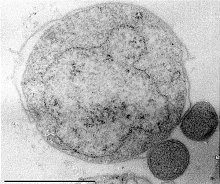Related Research Articles

Nanoarchaeota are a phylum of the Archaea. This phylum currently has only one representative, Nanoarchaeum equitans.

The Crenarchaeota are archaea that have been classified as a phylum of the Archaea domain. Initially, the Crenarchaeota were thought to be sulfur-dependent extremophiles but recent studies have identified characteristic Crenarchaeota environmental rRNA indicating the organisms may be the most abundant archaea in the marine environment. Originally, they were separated from the other archaea based on rRNA sequences; other physiological features, such as lack of histones, have supported this division, although some crenarchaea were found to have histones. Until recently all cultured Crenarchaea had been thermophilic or hyperthermophilic organisms, some of which have the ability to grow at up to 113 °C. These organisms stain Gram negative and are morphologically diverse having rod, cocci, filamentous and oddly shaped cells.

In taxonomy, the Korarchaeota are a phylum of the Archaea. The name is derived from the Greek noun koros or kore, meaning young man or young woman, and the Greek adjective archaios which means ancient. They are also known as Xenarchaeota.
The Acholeplasmatales are an order in the class Mollicutes, containing only one family, Acholeplasmataceae, comprising the genera Acholeplasma and Phytoplasma. Yet, Phytoplasma has the candidatus state, because members still could not be cultured.

Halomonadaceae is a family of halophilic Proteobacteria.
Eggerthella is a bacterial genus of Actinobacteria, in the family Coriobacteriaceae. Members of this genus are anaerobic, non-sporulating, non-motile, Gram-positive bacilli that grow singly, as pairs, or in short chains. They are found in the human colon and feces and have been implicated as a cause of ulcerative colitis, liver and anal abscesses and systemic bacteremia.
Anaerobacter is a genus of Gram-positive bacteria related to Clostridium. They are anaerobic chemotrophs and are unusual spore-formers as they produce more than one spore per bacterial cell. They fix nitrogen. Their G+C content is 29%. Only one species of this genus has been described.
Methanococcus is a genus of coccoid methanogens of the family Methanococcaceae. They are all mesophiles, except the thermophilic M. thermolithotrophicus and the hyperthermophilic M. jannaschii. The latter was discovered at the base of a “white smoker” chimney at 21°N on the East Pacific Rise and it was the first archaeal genome to be completely sequenced, revealing many novel and eukaryote-like elements.
Mycobacterium celatum is a species of the phylum Actinobacteria, belonging to the genus Mycobacterium.
Alteromonas is a genus of Proteobacteria found in sea water, either in the open ocean or in the coast. It is Gram-negative. Its cells are curved rods with a single polar flagellum.
In taxonomy, Caldivirga is a genus of the Thermoproteaceae.
Paracoccus is a genus of bacteria in the family Rhodobacteraceae.
In taxonomy, Hyperthermus is a genus of the Pyrodictiaceae.
In taxonomy, Methanimicrococcus is a genus of the Methanosarcinaceae. The members of this genus have been found in pharmaceutical wastewater, and they can contribute to the degradation of organic contaminants.
In taxonomy, Methanomethylovorans is a genus of microorganisms with the family Methanosarcinaceae. This genus was first described in 1999. The species within it generally live in freshwater environments, including rice paddies, freshwater sediments and contaminated soil. They produce methane from methanol, methylamines, dimethyl sulfide and methanethiol. With the exception of M. thermophila, which has an optimal growth temperature of 50 °C, these species are mesophiles and do not tend to grow at temperatures above 40 °C.
In taxonomy, Natrinema is a genus of the Halobacteriaceae.
Mycobacterium novocastrense is a species of Mycobacterium.
Thermoanaerobacter is a genus in the phylum Firmicutes (Bacteria). Members of this genus are thermophilic and anaerobic, several of them were previously described as Clostridium species and members of the now obsolete genera Acetogenium and Thermobacteroides
Oxobacter pfennigii, previously known as Clostridium pfennigii, is a bacterium belonging to the Firmicutes.
Paenibacillus durus, previously known as Clostridium durum and Paenibacillus azotofixans, is a bacterial species belonging to the Firmicutes.
References
- 1 2 3 Parte, A.C. "Oxobacter". LPSN .
- ↑ Krumholz LR, Bryant MP (1985). "Clostridium pfennigii sp. nov. uses methoxyl groups of monobenzenoids and produces butyrate". Int J Syst Bacteriol. 35 (4): 454–456. doi: 10.1099/00207713-35-4-454 .
- ↑ Collins MD, Lawson PA, Willems A, Cordoba JJ, Fernandez-Garayzabal J, Garcia P, Cai J, Hippe H, Farrow JA (1994). "The phylogeny of the genus Clostridium: proposal of five new genera and eleven new species combinations". Int J Syst Bacteriol. 44 (4): 812–826. doi: 10.1099/00207713-44-4-812 . PMID 7981107.
| This Clostridiales-related article is a stub. You can help Wikipedia by expanding it. |